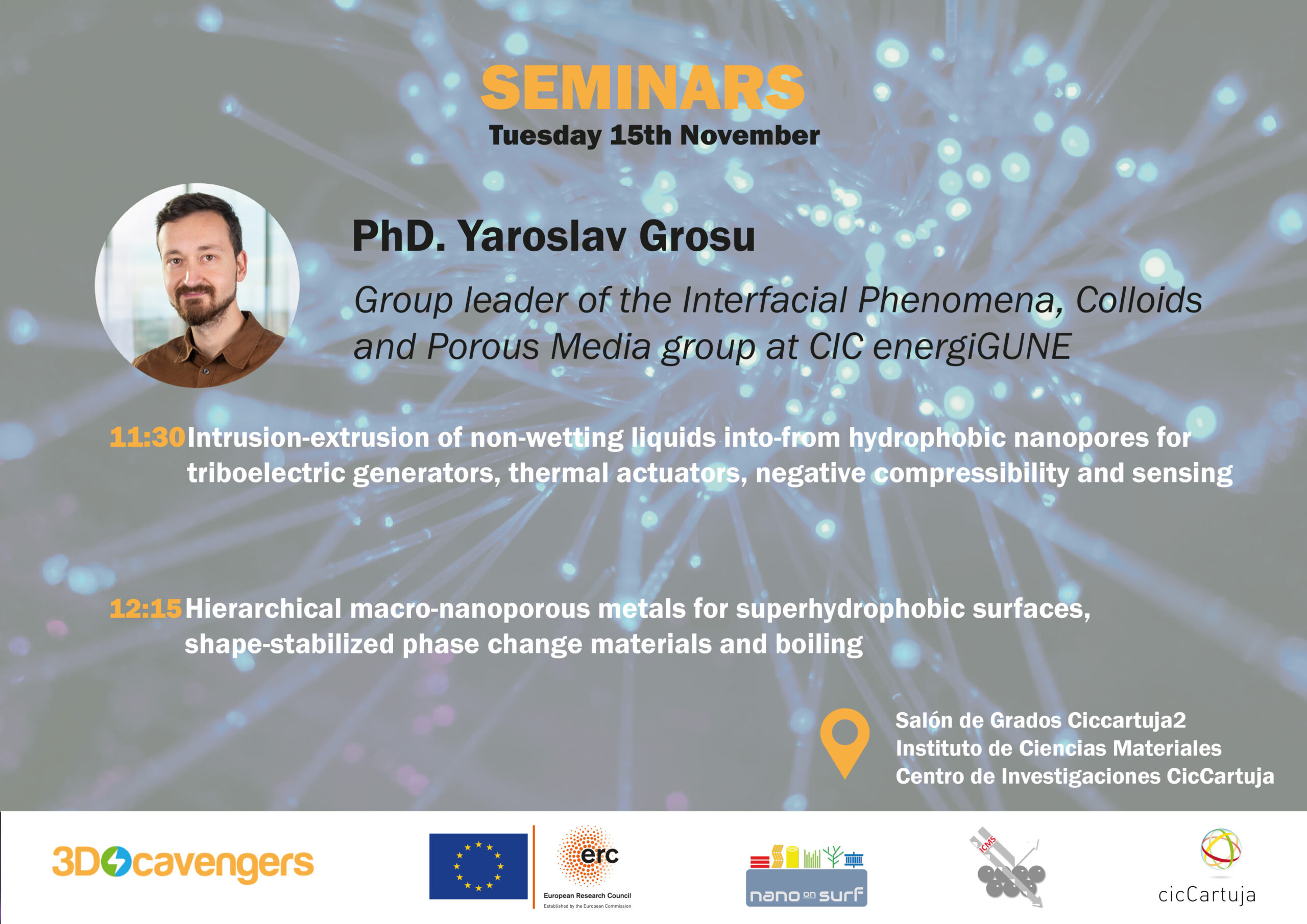News

On Tuesday 15 November, the group leader of the Interfacial Phenomena, Colloids and Porous Media group at CIC energiGUNE, Ph.D. Yaroslav Grosu, will give two seminars within the 3DScavengers in Instituto de Ciencias Materiales de Sevilla (ICMS).
He will talk at 11:30 about Intrusion-extrusion of non-wetting liquids into-from hydrophobic nanopores for
triboelectric generators, thermal actuators, negative compressibility and sensing and at 12:15 he will provide other talk entitled Hierarchical macro-nanoporous metals for superhydrophobic surfaces,
shape-stabilized phase change materials and boiling.
You can attend online at this link or in person in ICMS. If you are not a member of this center to access the facilities you need to send your name, surname and ID to the following email (3dscavengers@icmse.csic.es).
Abstracts
1st seminar: intrusion(wetting)/extrusion(drying) of liquids in/from lyophobic nanoporous systems is key in many fields, including chromatography, nanofluidics, biology and energy materials. In this talk, we present our recent findings in understanding microscopic mechanism of intrusion-extrusion process obtained with high-pressure intrusion-extrusion cycling, in situ structural analysis using neutrons scattering, and atomistic simulations. The fundamental questions targeted in these works are motivated by the applicability of intrusion-extrusion process for mechanical energy storage and conversion [1], thermomechanical-to-electrical energy conversion [2], thermal actuation [3], negative compressibility [4, 5] and sensing [6]. In particular, we discuss:
• Effect of crystal size and macroscopic morphology on the intrusion-extrusion process [1]
• solid-liquid contact electrification and heat of solid-liquid interface development upon water intrusion into hydrophobic nanopores, and how they can be used for a new type of regenerative shock-absorbers for electric and hybrid vehicles [2]
• temperature-stimulated intrusion-extrusion cycle of water into flexible nanopores for thermal-to-mechanical energy conversion and compact thermal actuation [3]
• pronounced inflation of flexible hydrophobic nanoporous materials induced by water intrusion reaching giant effects of negative compressibility [4, 5]
• water adsorption-extrusion cycle provoked by variation of CO2 pressure for sensing applications [6]
[1] Zajdel et al Turning Molecular Springs into Nano-Shock Absorbers: The Effect of Macroscopic Morphology and Crystal Size on the Dynamic Hysteresis of Water Intrusion–Extrusion into-from Hydrophobic Nanopores. ACS Appl Mater Interfaces 2022
[2] www.electro-intrusion.eu
[3] Chorążewski et al Compact Thermal Actuation by Water and Flexible Hydrophobic Nanopore ACS Nano 2021
[4] Tortora et al Giant Negative Compressibility by Liquid Intrusion into Superhydrophobic Flexible Nanoporous Frameworks ACS Nano letters 2021
[5] Zajdel et al Inflation Negative Compressibility during Intrusion-Extrusion of a Non-Wetting Liquid into a Flexible Nanoporous Framework J Phys Chem Lett 2021
[6] Anagnostopoulos et al Giant Effect of Negative Compressibility in a Water–Porous Metal–CO2 System for Sensing Applications ACS Appl Mater Interfaces 2020
2nd seminar: Largely inspired by nature, hierarchical porous materials are attractive for a wide range of applications as they provide a unique combination of transport and interfacial properties. Hierarchical macro-nanoporous metals (HMNPM) are of particular interest due to their widespread use as construction materials, their high thermal and electrical conductivities, high volumetric macroporosity as well as strong capillary forces and large surface area. In this talk, we present our recent findings in synthesis and tuning of HMNPMs [1-3] as well as their use for superhydrophobic and superlyophobic surfaces [4-6], shape-stabilized phase change materials [7] and boiling applications. In particular, we discuss:
• A single-step synthesis of HMNPMs via dealloying close-to-eutectic alloys [1]
• Stability vs porosity compromise for HMNPMs resolved by the use of ternanry alloys [2]
• Tuning modality of HMNPMs via deallying kinetics [3]
• Chemical-free method for superhydrophobic and superlyophobic surfaces synthesis [4-6]
• HMNPMs for shape-stabilized phase change materials with high thermal energy capacity, enhanced thermal conductivity and superior antileakage performance [7]
• The use of HMNPMs for boiling-based heat transer intensification
Biosketch
Yaroslav Grosu is group leader of the Interfacial Phenomena, Colloids and Porous Media group at CIC energiGUNE research center. The group is dedicated to cross-disciplinary research targeted at energy storage and conversion applications. After his cotutelle PhD at the Blaise Pascal University (France) and the National Technical University of Ukraine, Yaroslav Grosu gained his research experience at various laboratories, including the University of California at Davis (USA), University of Birmingham (UK) and International Iberian Nanotechnology Laboratory (Portugal). His current scientific interests include solid-liquid interfaces, hierarchical porous materials, nanofluids and corrosion. Y Grosu currently coordinates FET-proactive Electro-intrusion project (www.electro-intrusion.eu) and, starting from 2022, he is a Ramon y Cajal fellow.